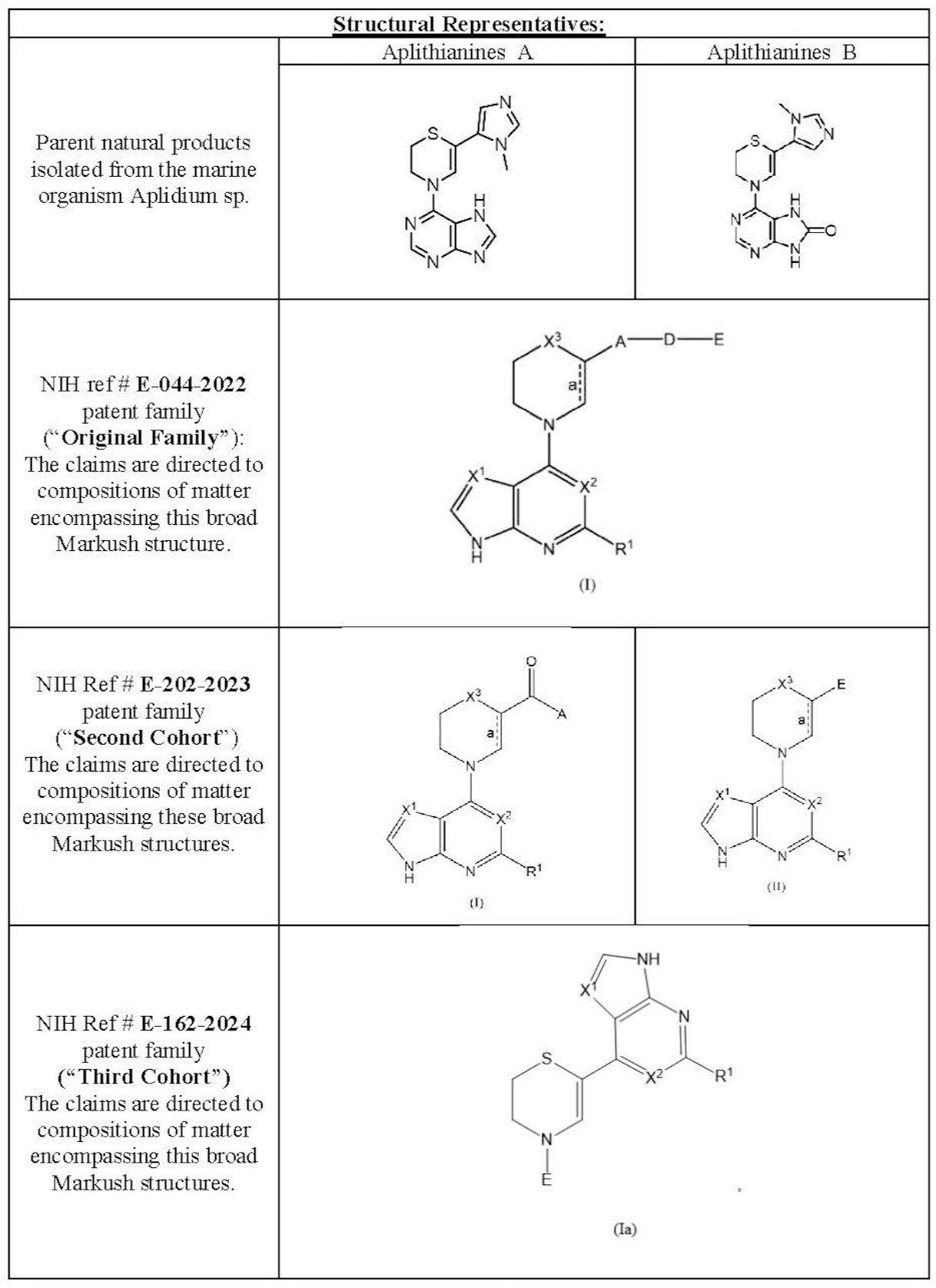Novel Kinase Inhibitory Thiazines
Summary
The National Cancer Institute (NCI) seeks research co-development partners and/or licensees for a class of novel aplithianine-derived small molecule analogs that compete with ATP for binding on a range of clinically relevant kinases including:
- Oncogenic gene fusion DNAJB1-PRKACA (PKADJ)
- Wild type protein kinase A (PKA)
- Protein kinase G (PKG)
- Ccdc2-like kinases (CLK) 1 & 2
- DYRK family of kinases
Description of Technology
In 2022, the NCI Molecular Targets Program (MTP) completed a screen of ~150,000 pre-fractionated natural products from the NCI Program for Natural Product Discovery (NPNPD). From this screen, a class of active compounds, named Aplithianines A & B (isolated from the marine organism Aplidium sp.), showed broad potential applicability to numerous kinases of importance including, but not limited to:
- Oncogenic gene fusion DNAJB1-PRKACA (PKADJ)
- Implicated in an ultra-rare adolescent liver cancer
- Wild type protein kinase A (PKA)
- Implicated in Cushing’s Disease
- Protein kinase G (PKG)
- Potential treatment of malaria
- Ccdc2-like kinases (CLK) 1 & 2
- Implicated in gastric cancer
- DYRK family of kinases
- Implicated in gastric or colon cancer as well as infections caused by a protozoa or parasites
The original cohort of compounds, including the pharmaceutical compositions of the natural products Aplithianine A and Aplithianine B, as well as a range of synthetic derivatives are described in NIH Technology Ref # E-044-2022.
This technology (NIH Ref # E-202-2023) describes the Second Cohort of compounds that comprise the same chemical scaffold of the broadest generic formula in the Original Family but represent a patentably distinct, subgenus formula. This Second Cohort of compounds shares the same chemical scaffold as aplithianine but have been optimized through extensive medicinal chemistry efforts to increase binding affinity to the oncogenic fusion kinase called DNAJB1-PRKACA (PKADJ) and its wild-type counterpart protein kinase A (PKA). These new compounds, like the Original Family compounds, compete with ATP for binding on these kinases and other related kinases (namely, protein kinase G, cdc2-like kinases (CLK) 1 & 2, and the DYRK family of kinases). However, the compounds described in this Second Cohort exhibit improved low nanomolar binding affinity and high activity in secondary assays.
A Third Cohort of compounds, namely the Reverse Thiazine Kinase inhibitors, are described in NIH Ref # E-162-2024. They are also structurally related to, but patentably distinct from the compounds described in the patent filings for the Original Family and Second Cohort.

The specificity of several of the compounds have been examined in kinase panels to demonstrate that while applicable to a range of kinases, they are not promiscuous kinase inhibitors. The subject kinase inhibitors have broad potential commercial applicability’s for cancer, immune suppression, preventing organ rejection, treating diabetic neuropathic pain, malaria, or protozoa infection. To date there are no approved therapeutics targeting DNAJB1-PRKCA, an oncogenic gene fusion is ubiquitously and exclusively detected in the tumors of patients with ultra-rare fibrolamellar hepatocellular carcinoma FLHCC.
The NCI seeks licensing and/or co-development research collaborations for the future development of Kinase Inhibitory Aplithianines targeting DNAJB1-PRKACA (PKADJ), PKA, PKG, CLK, and/or DYRK.
Potential Commercial Applications
• Gastric cancer
• Ultra-rare adolescent liver cancer
• Solid cancers susceptible to kinase inhibitors
• Cushing’s Disease
• Transplantation
• Diabetic neuropathic pain
• Malaria
• Protozoa infection
Competitive Advantages
- Applicability to numerous clinically relevant kinases, including:
- Oncogenic gene fusion DNAJB1-PRKACA (PKADJ)
- Wild type protein kinase A (PKA)
- Protein kinase G (PKG)
- Ccdc2-like kinases (CLK) 1 & 2
- DYRK family of kinases
- Applicable to a range of kinases, but are not promiscuous inhibitors
- Broad potential commercial applicability for several blockbuster indications, including: cancer, immune suppression, transplantation, diabetic neuropathic pain, malaria, and protozoa infection
- No approved therapeutics targeting DNAJB1-PRKCA
